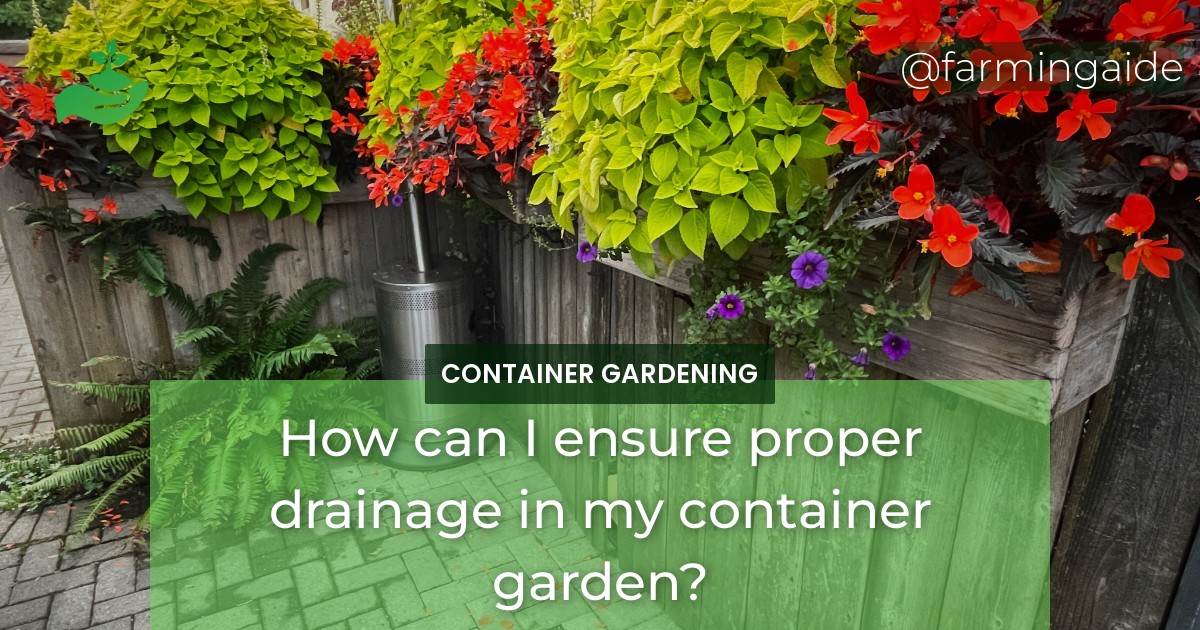Proper drainage is essential for the success of container gardening. Without adequate drainage, plant roots may become waterlogged and suffocate, leading to poor plant growth or even death. In this article, we will discuss the importance of proper drainage in container gardening, the problems caused by poor drainage, the benefits of good drainage, ways to ensure proper drainage in container gardening, and maintenance of drainage.
Importance of Proper Drainage in Container Gardening
Problems Caused by Poor Drainage
Waterlogging
Waterlogging occurs when soil becomes saturated with water and there is no place for the excess water to drain. This can lead to a lack of oxygen in the soil which can suffocate plant roots, leading to poor growth or death.
Root Rot
Root rot is a disease that affects plant roots and is caused by soil-borne fungi. It thrives in wet, poorly-drained soil and can kill plants. Symptoms include yellowing leaves, wilting, and plant death.
Nutrient Deficiency
Poor drainage can lead to a lack of nutrients in the soil, as the water can wash them away.
Benefits of Good Drainage
Improved Plant Growth
Good drainage allows plants to access nutrients and oxygen, promoting healthy growth and development.
Prevention of Diseases
Good drainage can prevent the buildup of excess water, which can harbor disease-causing organisms such as fungi.
Prevention of Pests
Standing water can attract pests such as mosquitoes and other insects.
Ways to Ensure Proper Drainage in Container Gardening
Choose the Right Soil
Choosing the right soil is an essential step in ensuring proper drainage. Several types of soil are suitable for container gardening:
Soil Amendments
- Adding organic matter to soil can improve drainage by increasing soil structure and pore space, allowing water to flow through more easily.
- Perlite, vermiculite, and sand can be added to soil to improve drainage.
Soilless Mixes
- Soilless mixes, such as peat moss, coconut coir, and perlite, can provide excellent drainage for container gardening.
- These mixes are lightweight, which can be beneficial for larger containers.
Coarse Materials
- Adding coarse materials such as gravel or rocks to the bottom of a container can improve drainage.
- The coarse materials create a layer for excess water to flow through, preventing waterlogging.
Use the Correct Container
Size of the Container
Containers that are too small can lead to waterlogging, as there is not enough soil to absorb excess water. Choose a container that is appropriate for the size of the plant.
Number of Drainage Holes
Containers should have multiple drainage holes to allow excess water to flow out.
Container Material
Consider the material of the container when choosing one for container gardening. Plastic containers tend to retain more water than clay or ceramic containers, which can be beneficial for plants that require more moisture.
Proper Watering Techniques
Frequency of Watering
The frequency of watering depends on several factors, including the size of the container, the type of plant, and the weather conditions. In general, it is better to underwater than overwater.
Amount of Water
Water plants until water flows out of the drainage holes, ensuring that the entire root system is moistened.
Watering from the Bottom
Watering from the bottom can help prevent waterlogging by allowing the roots to absorb water as needed.
Maintenance of Drainage
Clearing Drainage Holes
Regularly check and clear drainage holes to ensure that water can flow freely out of the container.
Replacing Soil
Over time, soil may become compacted and lose its ability to drain properly. Replacing soil can help ensure good drainage.
Monitoring Plant Health
Regularly monitor plant health to catch any drainage problems early, before they become severe.
Conclusion
Proper drainage is essential for the success of container gardening. By choosing the right soil, container, and proper watering techniques, gardeners can ensure that their plants thrive. Regular maintenance of drainage is also important to catch any problems early and prevent poor plant growth.
RELATED ARTICLES:


